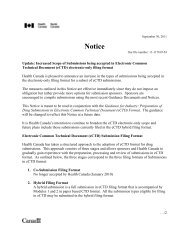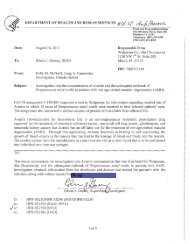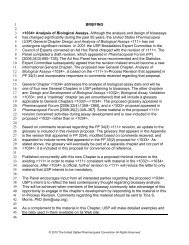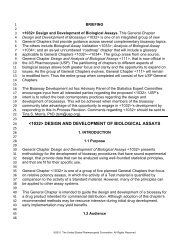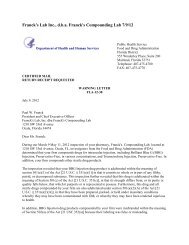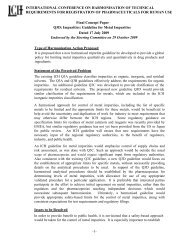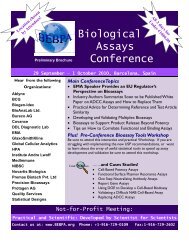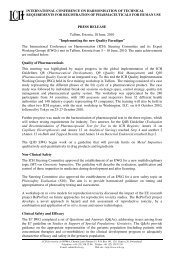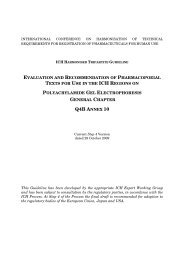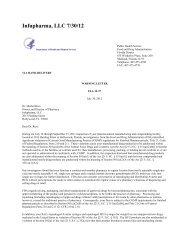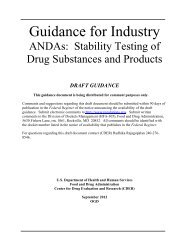UK – MHRA- Cold Chain Distribution - IPQ
UK – MHRA- Cold Chain Distribution - IPQ
UK – MHRA- Cold Chain Distribution - IPQ
You also want an ePaper? Increase the reach of your titles
YUMPU automatically turns print PDFs into web optimized ePapers that Google loves.
Good <strong>Distribution</strong> Practices<br />
(GDP‘s) & Pharma Supply <strong>Chain</strong><br />
Mgt<br />
Migration from GMPs into the Pharma Supply <strong>Chain</strong><br />
Regulations overview <strong>–</strong> PDA March 1 st , 2011<br />
Dave Ulrich <strong>–</strong> Abbott Pharma Dist QA
Major Transformational Trends for the Pharma Supply <strong>Chain</strong><br />
1. From GMP to GDPs<br />
Quality systems expanded from mfg‘ing into both 1) the Pharma Mfg‘ing<br />
supply chain (including Clinicals) and 2) the Commercial Dist supply chain<br />
Stand alone GDPs are ―new‖ (used to be a subset of GMPs)<br />
2. GxPs specific to pharma (and device) supply chain<br />
World wide >35 GDPs (WHO and FDA/EU)<br />
All are similar, but some have specifics (Argentina, Brazil, etc)<br />
3. Initial Focus was ―cold chain‖, now expanded to GS1, anticounterfeit<br />
and diversion, ―normal channel/trade (licensed trade partner), quality<br />
agreements and data sharing (to include LSP and TSP)<br />
4. Pedigree (ePedigree) and serialization<br />
Turkey, S. Korea, Argentina, etc<br />
5. Increased regulatory focus <strong>–</strong> standard audit items<br />
2
Table of Content<br />
• Good <strong>Distribution</strong> Practices (GDP)<br />
• Updated and Newly Issued Regulations and Guidelines<br />
• WHO- Draft GDP‘s<br />
• Europe <strong>–</strong> Guidelines on GDP‘s<br />
• Europe - International Pharmaceutical Excipients Council<br />
• Europe <strong>–</strong> Consolidated directive 2001/83/EC<br />
• European Medicines Agency (EMA): ―The QP declaration template‖<br />
• IATA <strong>–</strong> Logistics for Temperature Sensitive healthcare products<br />
• FDA to Revise Component GMP‘s to Bolster Supply <strong>Chain</strong> Security<br />
• USP_Chapter_1118- Monitoring device- Time, Temperature and Humidity<br />
• Saudi Food & Drug Authority<br />
• Taiwan - Precaution of on-site sampling for vaccine testing and sealing operation [DRAFT]<br />
• Romanian Directive- Legislation Change- Control of temperature/humidity during transportation<br />
• Singapore - Health Sciences Authority Guidance notes on GDP‘ DRAFT<br />
• Czech GDP Guidelines : DIS-15 version 1 Monitoring and temperature control during storage and<br />
transport of medicinal products.<br />
• Czech GDP Guidelines : DIS-11 Guidelines for correct distribution practice of human medicinal<br />
products<br />
• India‘s Pharma Mfg‘ers Guidelines (not the Gov‘t‘s)<br />
3
Table of Contents<br />
• Egypt- Minister Decree for Wholesalers <strong>–</strong> Circular No. 4/2009<br />
• Australia <strong>–</strong> Draft Code of Good Wholesaling Practice (partner w/FDA on audits)<br />
• Indonesia <strong>–</strong> GMP Requirements on warehousing or distribution<br />
• Pakistan <strong>–</strong> Drug Act of 1976<br />
• Brazil- Resolution <strong>–</strong>RDC No. 234<br />
• Health Canada- 0069 Guidelines for: Temp control of Drug Products during Storage and Trans.<br />
• Irish Medicines Board (IMB)<br />
• Japan <strong>–</strong> Biological Pharma revision H15.5.15 (rPAL)<br />
• <strong>UK</strong>- <strong>MHRA</strong> - GDP Risk Assessment Strategy<br />
• <strong>UK</strong> - <strong>MHRA</strong> - Updated Policy on returns of non-defective refrigerated (2-8c) medicinal products<br />
• <strong>UK</strong> - <strong>MHRA</strong>- <strong>Cold</strong> <strong>Chain</strong> <strong>Distribution</strong><br />
• <strong>UK</strong> - <strong>MHRA</strong> - Guidance on preventing breaches in the cold chain for medicinal products<br />
• ISRAEL <strong>–</strong> The Status of Current GDP Regulations in Israel (adopt EU &/or WHO)<br />
• Malaysia - National Pharmaceutical Control Bureau Ministry of Health Malaysia (NPCB) <strong>–</strong> Guidelines<br />
on Good <strong>Distribution</strong> Practice (GDP)<br />
• UAE Circular No. 246-2011<br />
• Argentina: ―Regulating the <strong>Cold</strong> <strong>Chain</strong> of Medicines‖ (Ley 26492)<br />
• FDA <strong>–</strong> Standardized Numerical Identifier<br />
4
Good <strong>Distribution</strong> Practices (GDP‘s)<br />
5<br />
Author(s): • N/A<br />
Date: • N/A<br />
Web Link:<br />
http://www.pda.org/MainMenuCatego<br />
ry/Publications/PDA-Letter/The-<br />
Status-of-Current-Good-<strong>Distribution</strong>-<br />
Practice-GDP-Regulations-in-<br />
Israel.aspxlink<br />
This is an example slide<br />
to show the format of the<br />
consecutive slides. It has<br />
the author, date<br />
published, hyperlink to<br />
the document and picture.
Good <strong>Distribution</strong> Practices (GDP)<br />
Three main components of GDPs<br />
Good Import<br />
Practices (GIPs)<br />
Good <strong>Cold</strong> <strong>Chain</strong><br />
Practices<br />
(GCCPs)<br />
GDP<br />
<strong>Distribution</strong><br />
Control Systems<br />
(DCS)<br />
6<br />
FD&C Act<br />
GMPs<br />
GLPs<br />
GCPs<br />
Now GDP<br />
GDPs started with a focus<br />
on <strong>Cold</strong> <strong>Chain</strong><br />
Now migrated to holistic<br />
supply chain quality systems
Good <strong>Distribution</strong> Practices (GDP) <strong>–</strong> Regulation & Drivers<br />
C-TPAT, TSA (CCFS/CCSP)<br />
Rules of Origin (COO),<br />
10+2 (ocean transport),<br />
Trusted importer program<br />
ISA <strong>–</strong> Importer Self Assessment<br />
FEI rule Changes<br />
eDLRS and GS1<br />
Beyond Our Borders,<br />
FDA Green lane, Import<br />
optimization (AOCC),<br />
RF enabled info Flow and<br />
“supplier supplier”<br />
information,<br />
Lacey Amendment, etc.<br />
Good Import<br />
Practices<br />
(GIPs)<br />
Good <strong>Cold</strong><br />
<strong>Chain</strong> Practices<br />
(GCCPs)<br />
GDP<br />
7<br />
<strong>Distribution</strong><br />
Control<br />
Systems (DCS)<br />
RF TT, ISS Qualification,<br />
“Import/Export ”<br />
Issues, returns, restock, Reverse<br />
Logistics Complaint mgt, Quality<br />
Agreements<br />
GS1 (GTIN, GLN),<br />
Track and Trace,<br />
Authentication,<br />
ePedigree,<br />
Serialization &<br />
Dist. Control<br />
Dingle Bill (HR 759),<br />
Buyer- Matheson (HR 5839),<br />
Bennet Bill (SB 3690)<br />
FDA SNI Sec. 913-505D(b)(2)<br />
FDA UDI<br />
CA SB 1307 (track & trace)<br />
Many other country regs
Updated and Newly Issued Regulations and Guidelines<br />
Expanded focus on regulatory<br />
AND<br />
Standards-based Guidance<br />
Recently Issued/<br />
Updated<br />
Process<br />
PDA Technical Support<br />
No 39 Revised 2007<br />
No 46 Issued 2009<br />
Regulatory Guidances<br />
Argentina Egypt Romania<br />
Australia FDA Saudi Arabia<br />
Austria ICH Singapore<br />
Brazil India (IPPO) S. Africa<br />
Canada Ireland S. Korea<br />
China Italy UAE<br />
Czech Republic Malaysia Venezuela<br />
EU Mexico WHO<br />
EMA <strong>MHRA</strong><br />
New PDA guidance<br />
coming out<br />
8<br />
IATA Labeling<br />
Standard<br />
Recently Issued/<br />
Updated<br />
Standards<br />
USP <br />
IATA PCR, Ch. 17,<br />
2009<br />
AFF et SFSP*<br />
* Guide Pratique: <strong>Chain</strong>e du froid de medicament
WHO- Draft GDP‘s<br />
9<br />
Author(s): • N/A<br />
Date: • November 5, 2010<br />
Web Link:<br />
http://www.who.int/immunizati<br />
on_standards/model_require<br />
ments_v2b.pdf
WHO- Draft GDP‘s<br />
Summary:<br />
Of Note:<br />
•Guideline to set out the principal requirements for the safe storage and distribution of time<br />
temperature-sensitive pharmaceutical products (TSPP).<br />
•Balanced overview of the major aspects of good storage distribution practice for TTSPPs.<br />
•Reference requirements from GMP, GSP and GDP guidelines.<br />
•Listed requirements should be directly applicable to all countries (less developed as well as<br />
industrialized world).<br />
•Guideline contains regulations on the following points:<br />
•Quality management, organization and personnel<br />
•Premises and storage areas<br />
•Transport vehicles, external packaging and labeling<br />
•<strong>Distribution</strong> and shipping practice, documentation<br />
•Repackaging and relabeling<br />
•Complaints, recalls and returned products<br />
•Imports and contracting<br />
10
Europe <strong>–</strong> Guidelines on GDP‘s<br />
11<br />
Author(s): • N/A<br />
Date: • Dec 2009<br />
Web Link:<br />
http://ec.europa.eu/health/files/eudrale<br />
x/vol-4/gdpguidelines1.pdf<br />
FDA to partner with<br />
EU RA THIS Year<br />
draft joint GDPs<br />
Step towards ICH<br />
(just like Q7A)
Europe <strong>–</strong> Guidelines on GDP‘s<br />
Summary:<br />
Of Note:<br />
•Guidelines prepared in accordance with Article 10 of Council Directive 92/25/EEC of March 1992<br />
on the wholesale distribution of medicinal products for human use.<br />
•Level of quality should be maintained (wholesalers must comply with principles and guidelines on<br />
GDP‘s)<br />
•Personnel (a management representative should be appointed in each distribution point).<br />
•Documentation (must be made available on request of competent authorities, written procedures in<br />
place and records).<br />
•Specific temperature storage conditions (areas should be equipped with temperature recorders to<br />
record temperature).<br />
•Deliveries ( to authorized wholesalers or authorized persons only).<br />
•Transport of temperature controlled products (must be transported by appropriately specialized<br />
means).<br />
•Returns of non-defective medicinal products (special attention must be given to temperature<br />
controlled products. Advice should be sought from the holder of the marketing authorization or the<br />
QP of the manufacturer of the product.)<br />
•Records of returns and FIFO<br />
•Emergency plan for urgent recalls (procedure should be described in writing)<br />
12
Europe - International Pharmaceutical Excipients Council<br />
13<br />
Author(s): • IPEC-EUROPE:Dr.<br />
Mathias Brenken, Reiner<br />
Gellrich, Dr. Andreas<br />
Lekebusch, George<br />
Mansveld, Dr. Frank Milek,<br />
Dr. Alexander Schoch, Dr.<br />
Najib Sehat, Allan Whiston<br />
Date: • 2006<br />
Web Link:<br />
• IPEC-USA: ( see<br />
document for list)<br />
http://www.ipeceurope.org/UPLOADS/GDP_Guide_200<br />
6(1).pdf
Europe - International Pharmaceutical Excipients Council<br />
Summary: Standard GDP‘s<br />
Of Note: This guide provides additional explanatory notes to:<br />
“GOOD TRADE AND DISTRIBUTION PRACTICES FOR PHARMACEUTICAL<br />
STARTING MATERIALS” [1]<br />
World Health Organization, WHO Technical Report Series, No. 917, 2003<br />
What triggered this?<br />
Melamine, Heparin, ethylene glycol<br />
Economically motivated Adulteration<br />
14
Europe - International Pharmaceutical Excipients Council<br />
Extract of Guide : WHO GDP’s on the Left and IPEC explanatory notes on the right<br />
15
Europe <strong>–</strong> Consolidated directive 2001/83/EC<br />
16<br />
Author(s): • N/A<br />
Date: • 2004<br />
Web Link:<br />
http://www.edctp.org/fileadmin/documents<br />
/ethics/DIRECTIVE_200183EC_OF_THE<br />
_EUROPEAN_PARLIAMENT.pdf
Europe <strong>–</strong> Consolidated directive 2001/83/EC<br />
Summary: Wholesale <strong>Distribution</strong> of Medicinal Products must comply with GDP established by the<br />
Commission:<br />
•Principle<br />
•Personnel<br />
•Documentation<br />
•Premises and equipment<br />
•Deliveries to customers<br />
•Self inspections<br />
•Provision of Information to Member States in relation to wholesale activities<br />
Of Note: •―The level of quality [of medicinal products] should be maintained throughout the<br />
distribution network‖.<br />
•―A tracing system should enable any faulty product to be found‖<br />
•―There should be an effective recall procedures‖.<br />
17
European Medicines Agency (EMA)<br />
―The QP declaration template‖<br />
18<br />
Author(s): • European Medicines<br />
Agency<br />
Date: • December 2010<br />
Web Link:<br />
http://www.ema.europa.eu/docs/en_<br />
GB/document_library/Scientific_guid<br />
eline/2011/01/WC500100727.pdf
European Medicines Agency (EMA)<br />
―The QP declaration template‖<br />
Summary: •―The active substance supply chain of each of the active substance<br />
manufacturing sites listed in Part A has been established and documented‖<br />
Of Note: •QP vs<br />
•There exists a documented risk assessment for all sites in the supply chain of<br />
the active substance<br />
•Documents are available for inspection<br />
•RP<br />
19
IATA <strong>–</strong> Logistics for Temperature Sensitive Healthcare<br />
Products<br />
20<br />
Author(s): • N/A<br />
Date: • July 2007<br />
Web Link:<br />
http://gpo.web.abbott.com/qa/dist<br />
ributionops/documents/International%20<br />
Air%20Transportation%20Assc%<br />
20logistics%20for%20temperatur<br />
e%20sensitive%20healthcare%2<br />
0products.pdflink
IATA <strong>–</strong> Logistics for Temperature Sensitive Healthcare<br />
Products<br />
Summary: •Purpose of this chapter is to provide information on the factors that affect temperaturesensitive<br />
healthcare products and to indicate critical control points in the air transport<br />
logistics that can impact these sensitive products and to provide best practices<br />
conforming to regulatory agencies requirements.<br />
•Factors affecting temperature-sensitive of healthcare products<br />
•Standard techniques applicable to the commercial handling of most environmentallysensitive<br />
healthcare products by air…<br />
•Temperature control during transportation and storage<br />
•GMP‘s & GSP‘s<br />
•<strong>Cold</strong> chain management<br />
•Active and passive packaging system<br />
Of Note: •Quality Management Systems requirements (including exception management)<br />
•Processes and responsibilities of all parties, including the shipper, forwarder, ground<br />
handlers/transportation service provider, consignee and air carrier<br />
•Storage and warehousing requirements (including temperature mapping)<br />
•Introduction of new time & temperature sensitive handling label usage requirements<br />
21
FDA to Revise Component GMP‘s to Bolster Supply<br />
<strong>Chain</strong> Security<br />
22<br />
Author(s): • April Hollis<br />
Date: • May 2010<br />
Web Link:<br />
http://www.fdanews.com/newsl<br />
etter/article?issueId=13660&arti<br />
cleId=126708
FDA to Revise Component GMP‘s to Bolster Supply <strong>Chain</strong><br />
Security<br />
Summary: •―FDA is revising GMP regulations for incoming raw materials that would significantly<br />
improve drugmakers‘ control over suppliers and help secure the pharmaceutical supply<br />
chain against economically motivated adulterations‖.<br />
•Objective of the FDA: to control the risk of counterfeit, adulterated or misbranded<br />
products entering the supply chain.<br />
•Industry should be more proactive in predicting potential economically motivated<br />
adulterants and designing test methods and supply chain controls.<br />
•FDA encourages Manufacturers to warn each other about suppliers and materials that<br />
pose hazards. Plus they should notify FDA as soon as a problem is identified that could<br />
pose a health risk.<br />
•FDA noticed limited foreign supplier audits have become a concern.<br />
•Possible solution is to audit suppliers‘ control of the chain of ingredients as part of the<br />
qualification procedure.<br />
•Other solution is to add more effort to train procurement employees to incorporate quality<br />
standards in searches for suppliers.<br />
Of Note: •FDA to produce guidelines to promote safe supply chains (final version of the July 2009<br />
draft guidance on physical-chemical identifiers in solid oral dosage form of drug<br />
products). Did not get issued<br />
23
USP_Chapter_1118- Monitoring device- Time, Temperature and<br />
Humidity<br />
24<br />
Author(s): • N/A<br />
Date: • Dec 2009<br />
Web Link:<br />
http://www.pharmacopeia.cn/v29240/<br />
usp29nf24s0_c1118.html
USP_Chapter_1118- Monitoring device- Time, Temperature<br />
and Humidity<br />
Summary: •Background on science and technology of temperature and humidity monitoring.<br />
•Describes the available technologies and their performance characteristics + provides<br />
recommendations for verification and validation of performance.<br />
Of Note: •Temperature measurement technologies: Alcohol or Mercury Thermometers, chemical<br />
device, thermistor …<br />
•Time-Temperature integrators (TTI‘s): Chemical-Physical based, Diffusion based,<br />
Enzyme based …<br />
•Electronic Time- Temperature History recorders:- data loggers<br />
•Relative Humidity measurement technologies: sling psychrometer, hair hygrometer…<br />
•Validation of Temperature and Humidity monitoring devices: measurement accuracy,<br />
time accuracy…<br />
•How many electronic monitors / pallet / shipment<br />
•Are indicators OK<br />
25
Saudi Food & Drug Authority<br />
26<br />
Author(s): • Prof. Dr. Saleh.<br />
Bawazeer (Vice President<br />
for Drug Affairs).<br />
Date: • 09/02/1431H<br />
Web Link: N/A
Saudi Food & Drug Authority<br />
Summary: • Pharmaceutical products imported in Saudi must be transported in cooled<br />
containers and stored accordingly in order to be accepted.<br />
1. March 1 st , 2011 all 2-8C products have to have temperature monitoring for<br />
import compliance.<br />
2. By June 1 st , 2011 all CRT products have to have temperature monitoring for<br />
import compliance<br />
Of Note: ―No shipment of pharmaceutical products imported to the Kingdom will be cleared<br />
if it was proved that they were transported in non-cooled containers or stored in<br />
such a way contrary to the conditions recommended‖.<br />
27
Taiwan - Precaution of on-site sampling for vaccine testing and<br />
sealing operation [DRAFT]<br />
28<br />
Author(s):<br />
• Chief Dr. Wang<br />
of TFDA<br />
Date: • April, 2010<br />
Web Link: N/A
Taiwan - Precaution of on-site sampling for vaccine testing and<br />
sealing operation [DRAFT]<br />
Summary: •Electronic temperature monitor device should be introduced for cold chain<br />
temperature monitoring by the deadline of 31 Dec 2010.<br />
•Standard GDPs<br />
Of Note: ― By the deadline of 31 Dec 2010, electronic temperature monitor device<br />
should be introduced for cold chain temperature monitoring. After 31 Dec<br />
2010, TFDA will not process sampling for those use other device for<br />
temperature monitoring‖.<br />
29
Romanian Directive- Legislation Change- Control of<br />
temperature/humidity during transportation<br />
Summary: NMA No. 30/24.09.2009 was updated with the following<br />
changes:<br />
- a certificate of conformity is no longer requested to be<br />
attached to each shipment of medicines.<br />
- records for temperature and relative humidity<br />
measurements during transport should be provided , if<br />
applicable, in the conditions imposed by the manufacturer.<br />
- the copies of the Marketing Authorizations provided to the<br />
distributors should be accompanied by the approval letters<br />
for variations.<br />
-distributors should maintain the records for temperature<br />
and relative humidity measurements, if applicable, during<br />
the transport of medicines from the supplier, so that, when<br />
receiving the goods, the conformity of the results of<br />
measurements could be verified against the requirements<br />
stated in the Marketing Authorization and against the<br />
additional information regarding the transport conditions<br />
provided by the manufacturer .<br />
Of Note: •Changes were made to Romanian NMA Instruction No.<br />
30/24.09.2009 in December 2009 regarding temperature<br />
and humidity monitoring during transportation.<br />
30<br />
Author(s): • N/A<br />
Date: • Dec 2009<br />
Web Link: N/A
Singapore - Health Sciences Authority Guidance notes on GDP<br />
31<br />
Author(s): • N/A - Health Sciences<br />
Authority<br />
Date: • August 2010<br />
Web Link:<br />
http://www.hsa.gov.sg/publish/etc/m<br />
edialib/hsa_library/health_products_<br />
regulation/gmp/files_1.Par.84852.Fil<br />
e.dat/GUIDE-MQA-013-009.pdf
Singapore - Health Sciences Authority Guidance notes<br />
on GDP<br />
Summary: •Receiving and incoming checks<br />
•Labels/means to identify cold chain products<br />
•Temperature mapping<br />
•Thermometer and records<br />
•Maintenance program<br />
•Alarm system for temperature excursion<br />
•Backup generator/plan<br />
•Packing procedure and records, and independent check<br />
•Temperature mapping for vehicles or qualified/validated containers<br />
•Monitoring of storage conditions during transportation or simulation study<br />
•Delivery procedure<br />
•Procedure to handle temperature excursion<br />
•Procedure for handling returned products<br />
•Contracts<br />
•Training program and records<br />
Of Note: Quick easy read (like IMB)<br />
32
Czech GDP Guidelines : Monitoring and temperature control during<br />
storage and transport of medicinal products (DIS-15 V.1 )<br />
33<br />
Author(s): • N/A<strong>–</strong> Czeck<br />
GDP guidelines<br />
Date: • 2009<br />
Web Link:<br />
http://www.sukl.eu/medici<br />
nes/medicinal-productsdistributionguidelines?highlightWords<br />
=DIS-15
Czech GDP Guidelines: Monitoring and temperature control<br />
during storage and transport of medicinal products (DIS-15 V.1 )<br />
Summary: • Standard GDP to ensure, control and document temperature during storage and<br />
transport of medicinal products.<br />
Of Note: • Temperature map using measuring devices- required for storage.<br />
• Temperature during transport must be monitored with a measuring devices.<br />
• Measuring devices must be equipped with an alarm and calibrated (time<br />
between 2 subsequent calibrations should not be longer than 24 months).<br />
• Measuring device error should also be determined during calibration.<br />
• The used thermometers should not have a greater error than ± 0.5 °C for the<br />
monitoring of storage temperature for thermolabile medicinal products.<br />
• Used thermometers should not indicate greater error than ± 1.0°C for the<br />
monitoring of the temperature conditions other than those in the freezing and<br />
cooling appliances.<br />
• Thermolabile medicinal products are transported in cooling vehicles or in<br />
cooled transport containers, they are stored in order to avoid freezing (with the<br />
exception of medicinal products, which should be transported under freezing<br />
temperatures).<br />
34
Czech GDP Guidelines : Guidelines for correct distribution<br />
practice of human medicinal products (DIS-11 )<br />
35<br />
Author(s): • Unknown <strong>–</strong> Czeck<br />
GDP guidelines<br />
Date: • 2009<br />
Web Link:<br />
http://www.sukl.eu/medicines/m<br />
edicinal-products-distributionguidelines?highlightWords=DIS<br />
-11
Czech GDP Guidelines : Guidelines for correct distribution<br />
practice of human medicinal products (DIS-11 )<br />
Summary: • Distributors must observe the rules and guidelines of good distribution practice<br />
published by the European Commission<br />
• Standard GDP‘s for Storage, Transportation and distribution.<br />
• Medicinal products should be commonly stored separated from other marketable<br />
goods<br />
• Temperature is monitored and regularly recorded<br />
• Control should ensure that all parts of particular storage areas keep the<br />
temperature within the established temperature range<br />
• System of stock circulation introduced (i.e. ―first in - first out‖).<br />
• Products should be delivered only to other authorised distributors<br />
Of Note: This guideline is a translation of the European commission- EU Guidelines on Good<br />
<strong>Distribution</strong> Practice of medicinal products of Human use.<br />
36
India‘s Pharma Mfg‘ers Guidelines (not the Gov‘t‘s)<br />
37<br />
Author(s):<br />
Date: • June 2010<br />
Web Link:<br />
http://www.indiaoppi.com/pubcoldchainprod<br />
s.asp
India‘s Pharma Mfg‘ers Guidelines (not the Gov‘t‘s)<br />
38<br />
Author(s): • Dr. Surinder Singh<br />
Date: • 06-08-2009<br />
Web Link:<br />
http://www.indiaoppi.com/pubcol<br />
dchainprods.asp
India‘s Pharma Mfg‘ers Guidelines (not the Gov‘t‘s)<br />
Summary: Standard GDP‘s for <strong>Cold</strong> <strong>Chain</strong> Pharmaceutical Products:<br />
•Storing and Handling (seaports/airports, Stockist/Distributors,<br />
Retailers/Chemists)<br />
•Custom Clearance and Sample testing<br />
•Transportation using refrigerated Vans<br />
Of Note: •Temperature loggers in cold rooms<br />
•Practice FEFO ( First Expired First Out) in storage facility.<br />
•Temperature monitoring device with alarm<br />
39
Egypt- Minister Decree for Wholesalers <strong>–</strong> Circular<br />
No. 4/2009<br />
Out of the MOH concern for Egyptian patients’ welfare<br />
GSP = Good Storage Practices<br />
GDP = Good <strong>Distribution</strong> Practices<br />
40<br />
Author(s): • Dr. Madiha Ahmed<br />
• Dr. Abd El-Rahman<br />
Maged<br />
Date: • January 2009<br />
Web Link:<br />
http://www.mohp.gov.eg/
Egypt- Minister Decree for Wholesalers <strong>–</strong> Circular<br />
No. 4/2009<br />
41<br />
Author(s): • Dr. Madiha Ahmed<br />
• Dr. Abd El-Rahman<br />
Maged<br />
(Document Translated<br />
to English)<br />
Date: • January 2009<br />
Web Link:<br />
http://www.mohp.gov.eg/
Egypt- Minister Decree for Wholesalers <strong>–</strong> Circular<br />
No. 4/2009<br />
Summary: •Rules issued by the MOH and Population (resolution No. 25/2009)<br />
•Standard GDP‘s:<br />
-Temperature monitoring during cold storage<br />
-Temperature mapping of warehouses<br />
Of Note: •Insulated containers may be used for small volumes<br />
•Refrigerated transport for larger volumes<br />
•Temperature must be monitored and recorded<br />
42
Australia <strong>–</strong> Draft Code of Good Wholesaling Practice<br />
43<br />
Author(s): • N/A<br />
Date: • June 2006<br />
Web Link:<br />
http://gpo.web.abbott.com/qa/distri<br />
butionops/documents/Australian%20Draf<br />
t%20Code%20of%20Good%20Wh<br />
olesaling%20Practice_Jun06.pdf
Australia <strong>–</strong> Draft Code of Good Wholesaling<br />
Practice<br />
Summary: •Standard GDP‘s<br />
•Wholesalers are responsible to ensure medicine is stored and distributed within the<br />
label requirements of the manufacturer and in accordance with this code. Includes the<br />
distribution of temperature sensitive medicines via the cold chain.<br />
•Temperature sensitive therapeutic products (TSTPS)<br />
•Transport<br />
•Management of controlled goods, returned goods, product recalls, documentation.<br />
Of Note: •For TSTPS : temperature monitoring equipment and record<br />
•Goods with a manufacturer-specified temperature range should not be stored in a<br />
temporary stock location that could expose them to temperatures outside the specified<br />
range.<br />
•Goods requiring temperature maintenance in the range of + 2ºC to +8ºC should be<br />
labeled refrigerate <strong>–</strong> do not freeze. Goods requiring temperature maintenance in the<br />
range below 0ºC should be labeled keep frozen.<br />
44
Indonesia <strong>–</strong> GMP Requirements on warehousing or distribution<br />
45<br />
Author(s): • N/A<br />
Date: • N/A<br />
Web Link:<br />
http://gpo.web.abbott.com/qa/di<br />
stributionops/documents/Indonesia-<br />
GMP%20requirement%20on%2<br />
0warehousing%20or%20distrib<br />
ution.pdf
Indonesia <strong>–</strong> GMP Requirements on warehousing or distribution<br />
Summary: •ASEAN GMP guidelines describe requirements for:<br />
Of Note:<br />
•Warehouse facility (temperature monitoring for special storage conditions)<br />
•Handling of product recalls and returned drug products (report and record)<br />
•Quality control<br />
•Documentation ( inventory card, record of distribution)<br />
46
Pakistan <strong>–</strong> Drug Act of 1976<br />
47<br />
Author(s): • N/A<br />
Date: • 1976<br />
Web Link:<br />
N/A
Pakistan <strong>–</strong> Drug Act of 1976<br />
Summary: Drug Act not updated since 1976<br />
Of Note:<br />
• Temperature<br />
• Storage<br />
• <strong>Distribution</strong> records<br />
• Recording of Progress for recall<br />
48
Brazil- Resolution <strong>–</strong>RDC No. 234<br />
49<br />
Author(s): • N/A<br />
Date: • August 2005<br />
Web Link:<br />
http://gpo.web.abbott.com/qa/di<br />
stributionops/documents/Brazile%20-<br />
%20115%20-<br />
%20RDC%20n%20º%20234_0<br />
5%20-<br />
%20Importação%20Produtos%<br />
20Bioló….pdf
Brazil- Resolution <strong>–</strong>RDC No. 234<br />
Summary: •―Agência Nacional de Vigilância Sanitária‖ (HealthControl Agency) (ANVISA)<br />
adopted resolutions to regulate quality control activities for imports of<br />
biological products.<br />
Of Note:<br />
•Importing company must be registered<br />
•Records of temperature during transport chain and storage and a Quality<br />
Assurance Unit must be provided to the importing company.<br />
•Importing company must, upon clearance of the lots, present the ―Custody<br />
and Liability Commitment‖ for the product clearance until they deliver to the<br />
General Management of Ports, Airports and Borders the imported lot<br />
Clearance Certificate issued by the importing company quality assurance<br />
division, as well as a copy of the temperature records with all information<br />
50
Health Canada- 0069 Guidelines for: Temp control of Drug<br />
Products during Storage and Trans.<br />
51<br />
Author(s): • N/A <strong>–</strong> Health Canada<br />
Date: • Issued: January 2011<br />
Web Link:<br />
• Effective: April 2011<br />
http://www.hc-sc.gc.ca/dhpmps/alt_formats/pdf/compliconform/gmp-bpf/docs/GUI-0069eng.pdf
Health Canada- 0069 Guidelines for: Temp control of<br />
Drug Products during Storage and Trans.<br />
Summary: Standard GDP‘s:<br />
•Warehouse and storage (temperature monitored)<br />
•Transport of products (refrigerated vehicles/transportation containers should be<br />
mapped and monitored—if they are the primary means of environmental control).<br />
•―Drug products must be transported in a manner that ensures the products will<br />
be maintained within an acceptable temperature range as defined in the<br />
approved labeling and supported by stability data. Temperature excursions<br />
outside of their respective labeled storage conditions, for brief periods, may be<br />
acceptable provided stability data and scientific/technical justification exist<br />
demonstrating that product quality is not affected.‖<br />
Of Note: •Canadian GMP regulation (0069) was recently revised with the addition of<br />
section 4.1 to the requirements for return policy.<br />
•The revised documentation state: ―Documentation is available to support the<br />
rationale to place returned goods into inventory for further resale. Wholesalers<br />
should obtain guidance from importers/distributors to make an informed decision<br />
pertaining to the restock of the product.‖<br />
52
Irish Medicines Board<br />
53<br />
Author(s): • N/A<br />
Date: • March 2006<br />
Web Link:<br />
http://www.imb.ie/search.a<br />
spx?q=guide%20to%20co<br />
ntrol%20and%20monitorin<br />
g%20of%20Storage%20a<br />
nd%20Transportation&sta<br />
rt=0§ion=IMB
Irish Medicines Board<br />
Summary: Standard GDP‘s compliant to EU guidelines on GDP‘s:<br />
Of Note: •Discuss MKT<br />
•Storage (for temperature controlled products)<br />
•Transportation of cold chain products: (insulated container may be used for<br />
small volumes, refrigerated transport vehicles for larger volumes).<br />
•Temperature mapping and monitoring<br />
•Returns of <strong>Cold</strong> chain products (only if cold chain has not been compromised,<br />
batch number is known, and entire process is validated).<br />
•Controlled temperature storage/transportation (temperature mapping of<br />
warehouse, MKT)<br />
54
Japan <strong>–</strong> Biological Pharma revision H15.5.15<br />
55<br />
Author(s): • N/A -Director of<br />
Pharmaceutical and Food<br />
Safety Bureau<br />
Date: • May 2003<br />
Web Link:<br />
http://gpo.web.abbott.com/qa/distributionops/documents/Biological%20Pharma%20<br />
revision%20H15.5.15_Japan.pdf
Japan <strong>–</strong> Biological Pharma revision H15.5.15<br />
Summary: •‗Ministerial Ordinance to Partially Revise the Enforcement Regulations of<br />
the Pharmaceutical (rPAL) Affairs Law (MHLW Ministerial Ordinance No.<br />
89, 2003)‘ was promulgated together with the ‗Partial Revision of<br />
Medicines Designated by the Minister of Health, Labour and Welfare as<br />
stipulated in Article 15-4 Paragraph 2 Item 2b and e of the Enforcement<br />
Regulations of the Pharmaceutical Affairs Law (MHLW 2 Notification No.<br />
205, 2003)‘, and the ‗Complete Revision of Medical Devices Designated<br />
by the Minister of Health, Labour and Welfare as stipulated in Article 15-4<br />
Paragraph 2 Item 2 of the Enforcement Regulations of the Pharmaceutical<br />
Affairs Law (MHLW Notification No. 206, 2003)‘.<br />
Of Note:<br />
•Record and storage<br />
•Handling of medicine with mandatory registration<br />
56
<strong>MHRA</strong>- <strong>UK</strong>- GDP Risk Assessment Strategy<br />
57<br />
Author(s): • Peter Coombs<br />
Date: • November 2009<br />
Web Link:<br />
www.mhra.gov.uk
<strong>MHRA</strong>- <strong>UK</strong>- GDP Risk Assessment Strategy<br />
Summary: •Assessment is based on the outcome of an inspection and the classification of any<br />
deficiencies found<br />
•Other factors such as a persistently poor inspection history or action by<br />
enforcement may also affect the assessment.<br />
Of Note:<br />
Current full license holders<br />
•Inspection frequency will be a minimum of six months to a maximum of four years,<br />
dependant on inspection outcome and range of activities.<br />
•Companies awaiting routine inspection will be entered into the risk assessment<br />
system following their next inspection.<br />
New applicants<br />
•Most full license holders will be re-inspected in a maximum of 15 months. At this<br />
point they are risk assessed and their inspection frequency determined<br />
58
<strong>UK</strong> <strong>–</strong> <strong>MHRA</strong>- Updated Policy on returns of<br />
non-defective refrigerated (2-8c) medicinal products<br />
59<br />
Author(s): • Steve Todd<br />
Date: • April 2010<br />
Web Link:<br />
http://www.mhra.gov.uk/home/idcpl<br />
g?IdcService=GET_FILE&dDocNa<br />
me=CON079200&RevisionSelectio<br />
nMethod=Latest
<strong>UK</strong> <strong>–</strong> <strong>MHRA</strong>- Updated Policy on returns of<br />
non-defective refrigerated (2-8c) medicinal products<br />
Summary: • Wholesalers to comply with the principles of GDP is stated in European Directive<br />
92/25/EEC Article 10 and Rules and Guidance for Pharmaceutical Distributors 2007.<br />
•―products that have left the care of the wholesaler, should only be returned to<br />
saleable stock if………it is known that the goods have been stored and handled<br />
under proper conditions‖ (paragraph 23b) and, ―they have been examined and<br />
assessed by a person authorized to do so‖ (paragraph 23d).<br />
•Return of non-defective refrigerated medicinal products for those products returned<br />
from a customer operating from a licensed WL site should be completed as<br />
expeditiously as possible. With evidence of ―full knowledge‖<br />
•For those refrigerated medicinal products returned from unlicensed sites, the return<br />
should be completed within 24 hours including transport.<br />
Of Note: •By ― proper conditions‖ can only be interpreted as being under full GDP control by<br />
licensed sites.<br />
•―The Responsible Person or the authorized person must be able to demonstrate<br />
evidence of ―full knowledge‖ of the storage whilst at the unlicensed site, including<br />
transportation‖.<br />
60
<strong>UK</strong> <strong>UK</strong> <strong>–</strong> <strong>MHRA</strong>- <strong>–</strong> <strong>MHRA</strong>- <strong>Cold</strong> <strong>Chain</strong> <strong>Cold</strong> <strong>Distribution</strong> <strong>Chain</strong> <strong>Distribution</strong><br />
61<br />
Author(s): • Cheryl Blake<br />
Date: • Jan 2008<br />
Web Link:<br />
http://www.mhra.gov.uk/home/i<br />
dcplg?IdcService=GET_FILE&d<br />
DocName=CON028448&Revisi<br />
onSelectionMethod=Latest&no<br />
SaveAs=0&Rendition=WEB
<strong>UK</strong> <strong>–</strong> <strong>MHRA</strong>- <strong>Cold</strong> <strong>Chain</strong> <strong>Distribution</strong><br />
Summary: •Guidance on the regulatory requirement sand points to consider when developing<br />
a distribution strategy (based on the <strong>MHRA</strong> guidance note 6)<br />
•Control of storage and transportation temperature<br />
•Standard GDP‘s:<br />
-Storage and shipping temperature (controlled, compliance, temperature<br />
monitoring, temperature mapping, alarms, calibration etc.)<br />
-Risk assessment<br />
-Quality management system<br />
Of Note: Distributors should have in place:<br />
•A comprehensive quality system<br />
•A process for continual quality improvement<br />
•A cold chain distribution strategy<br />
•An ambient and cold chain distribution strategy<br />
•A risk assessment program<br />
62
<strong>UK</strong>- <strong>MHRA</strong>- Guidance on preventing breaches in the cold chain<br />
for medicinal products<br />
63<br />
Author(s): • Steve Todd<br />
Date: • Oct 2008<br />
Web Link:<br />
http://www.mhra.gov.uk/home/idcpl<br />
g?IdcService=GET_FILE&dDocNa<br />
me=CON038595&RevisionSelectio<br />
nMethod=Latest
<strong>UK</strong>- <strong>MHRA</strong>- Guidance on preventing breaches in the cold<br />
chain for medicinal products<br />
Summary: •Medicine be distributed through a network of licensed pharmaceutical<br />
wholesalers, who in turn, must comply with GDP.<br />
•The requirement for wholesalers to comply with the principles of GDP is stated<br />
in European Directive 92/25/EEC, which also provides that member states will<br />
perform inspections of their premises.<br />
•Standard GDP‘s : distribution, cold chain returns, transportation, storage, best<br />
practices, temperature monitoring.<br />
Of Note: •―If a cold chain product is to be returned to the wholesaler, this must occur<br />
within 24 hours of the original dispatch. After this time, the returned product<br />
cannot be considered for resale and must be sent for disposal‖.<br />
64
ISRAEL <strong>–</strong> The Status of Current GDP Regulations in Israel<br />
65<br />
Author(s): • Dr. Rachel Karpel<br />
Date: • June 2010<br />
Web Link:<br />
The Status of Current Good<br />
<strong>Distribution</strong> Practice (GDP)<br />
Regulations in Israel - Parenteral<br />
Drug Association
ISRAEL <strong>–</strong> The Status of Current GDP Regulations in Israel<br />
Summary: •Article review the legislation and regulation in Israel, proposed changes in<br />
conformance with the WHO GDP requirements, and current practices of<br />
wholesalers.<br />
•Pharmacist Ordinance of 1981 (requirement for wholesalers to have a<br />
―responsible pharmacist‖ on site‖).<br />
•― Pharmacist Regulations‖ revised in 2008 to achieve harmonization with<br />
European legislation ( adopted European GMP and requirement for a QP for<br />
batch release and direct licensing).<br />
•New GDP will include Safeguards to address counterfeiting issues.<br />
•New GDP will allow better standardization in regards to the supervision of<br />
wholesalers.<br />
Of Note: •Big changes are anticipated with the completion of the formal GDP legislation in<br />
Israel at the end of 2010 (adopting WHO guidelines).<br />
66
Malaysia <strong>–</strong> NPCB and MOH <strong>–</strong> Guidelines on Good <strong>Distribution</strong><br />
Practice (GDP)<br />
67<br />
Author(s): • National Pharmaceutical<br />
Control Bureau (NPCB)<br />
Ministry of Health (MOH)<br />
Malaysia<br />
Date: • January 2011<br />
Web Link:<br />
http://portal.bpfk.gov.my/
Malaysia <strong>–</strong> NPCB <strong>–</strong> Guidelines on Good <strong>Distribution</strong> Practice<br />
(GDP)<br />
Summary: •Used as a standard to justify status and as a basis for inspection of facilities<br />
(e.g. manufacturers, importers, wholesalers…). Procedures include the<br />
management of personnel, premises, facilities and adequate documentary<br />
procedures to preserve safety and quality of product.<br />
Of Note:<br />
•Appropriate storage conditions should be provided and justified by<br />
supportive stability data based on labeling statements. Storage time at a<br />
higher temperature is acceptable if justified and supported by suitable data<br />
generated under the proposed conditions. Special storage directions (e.g.<br />
shipping and transportation need to be requested from the manufacturer or<br />
supplier.<br />
•It is recommended that temperature monitors be located in areas that are<br />
most likely to show fluctuations<br />
•Quarantine status can be achieved either through the use of separate<br />
storage areas or by means of documentary or electronic data processing<br />
systems<br />
68
UAE Circular No. 246-2011<br />
69<br />
Author(s): • United Arab Emirates<br />
Ministry of Health<br />
• Attn: Dr. Amin Husain<br />
Al Amir<br />
Date: • Jan 2011<br />
Web Link:<br />
N/A
UAE Circular No. 246-2011<br />
Summary: •The containers should be temperature monitored and controlled during the<br />
shipment till U.A.E ports.<br />
Of Note:<br />
•The shipment of non medicinal materials such as raw materials used in<br />
medicine production/medical devices should be in containers with temperature<br />
Argentina: ―Regulating the <strong>Cold</strong> <strong>Chain</strong> of Medicines‖<br />
(Ley 26492)<br />
71<br />
Author(s):<br />
Date: • Approved March 2009<br />
Web Link:<br />
• Effective: March 2011<br />
http://www1.hcdn.gov.ar/dependenc<br />
ias/dsecretaria/Leyes/26492.pdf
Argentina: ―Regulating the <strong>Cold</strong> <strong>Chain</strong> of Medicines‖<br />
(Ley 26492)<br />
Summary: •Signed off by the President<br />
Of Note:<br />
•Not enforceable as a law, yet<br />
•Requiring manufacturers to indicate on all biopharma<br />
temperature through shelf-life, to the patient<br />
72
FDA <strong>–</strong> Standardized Numerical Identifier<br />
73<br />
Author(s): • N/A<br />
Date: • Mar 2010<br />
Web Link:<br />
http://www.fda.gov/Regul<br />
atoryInformation/Guidanc<br />
es/ucm125505.htm
FDA <strong>–</strong> Standardized Numerical Identifier<br />
Summary: • FDAAA Section 913 created Section 505D of the Federal Food Drug &<br />
Cosmetic act (Approved by Congress 2009)<br />
<strong>–</strong> To develop an SNI to be applied to a prescription drug at the point of manufacturing at<br />
the unit for interstate commerce package level<br />
<strong>–</strong> To be sufficient to facilitate identification, authentication and tracking and tracing of<br />
prescription drugs<br />
• This is the initial step by FDA to secure the drug supply chain<br />
• Repackagers are to link each new package back to the original manufacturer‘s<br />
SNI<br />
• SNIs do not apply to case and pallet level identification<br />
• SNI should be a serialized National Drug Code (sNDC) = NDC + serial number<br />
• Can append the expiration date and lot number to sNDC using GS1 standards<br />
• FDA believes the SNI should be applied in human and machine readable<br />
formats<br />
• For international standards the sNDC can be represented as a serialized Global<br />
Trade Item Number (GTIN)<br />
Of Note: •Enforceable for food already<br />
74
In Conclusion - The Transformational Trends for the Pharma<br />
Supply <strong>Chain</strong> are Here<br />
1. From GMP to GDPs<br />
<strong>–</strong> Quality systems expanded from mfg‘ing into both 1) the Pharma Mfg‘ing<br />
supply chain (including Clinicals) and the Commercial Dist supply chain<br />
<strong>–</strong> Stand alone GDPs are ―new‖ (used to be a subset of GMPs)<br />
2. GxPs specific to pharma (and device) supply chain<br />
<strong>–</strong> World wide >35 GDPs (WHO and FDA/EU)<br />
<strong>–</strong> All are similar <strong>–</strong> I showed you some of the specifics<br />
3. Initial Focus was ―cold chain‖, now expanded to GS1, anticounterfeit<br />
and diversion, ―normal channel/trade (licensed trade partner), quality<br />
agreements and data sharing (to include LSP and TSP)<br />
4. Pedigree (ePedigree) and serialization<br />
Turkey, S. Korea, Argentina, etc<br />
5. Increased regulatory focus <strong>–</strong> standard audit items<br />
ANVISA, KFDA, Turkey, Mexico, <strong>MHRA</strong>, etc<br />
75
Specifically<br />
• GS1 standards <strong>–</strong> worldwide<br />
• Pedigree (and ePedigree)<br />
<strong>–</strong> Track and Trace (TnT)<br />
• Sharing of Data (license, quality agreement, stability, etc)<br />
• Anti-counterfeit and diversion<br />
• More info 1D 2D Matrix & QR barcodes RFID<br />
• Interlinked IT systems (authenticate product flow and its information)<br />
<strong>–</strong> Returns/restocks, quarantine, TOT, joint anti-diversion / anticounterfeit<br />
procedures and agreements<br />
• Holistic Quality Systems for the supply chain<br />
76
Questions or Comments??<br />
77



